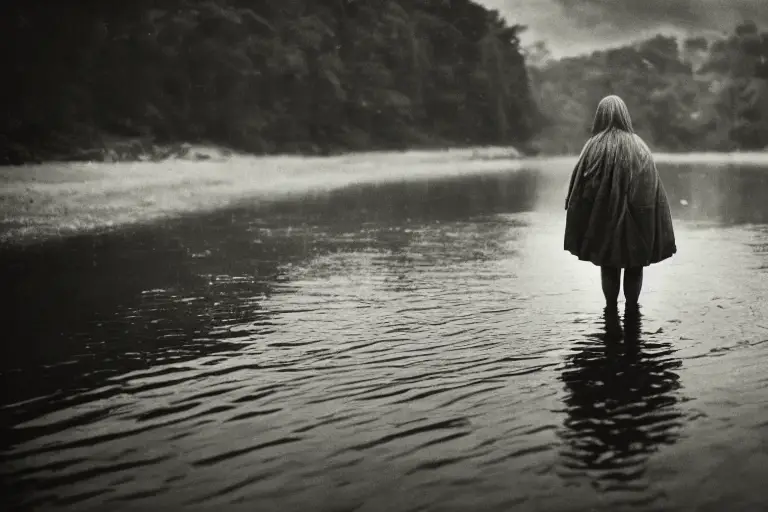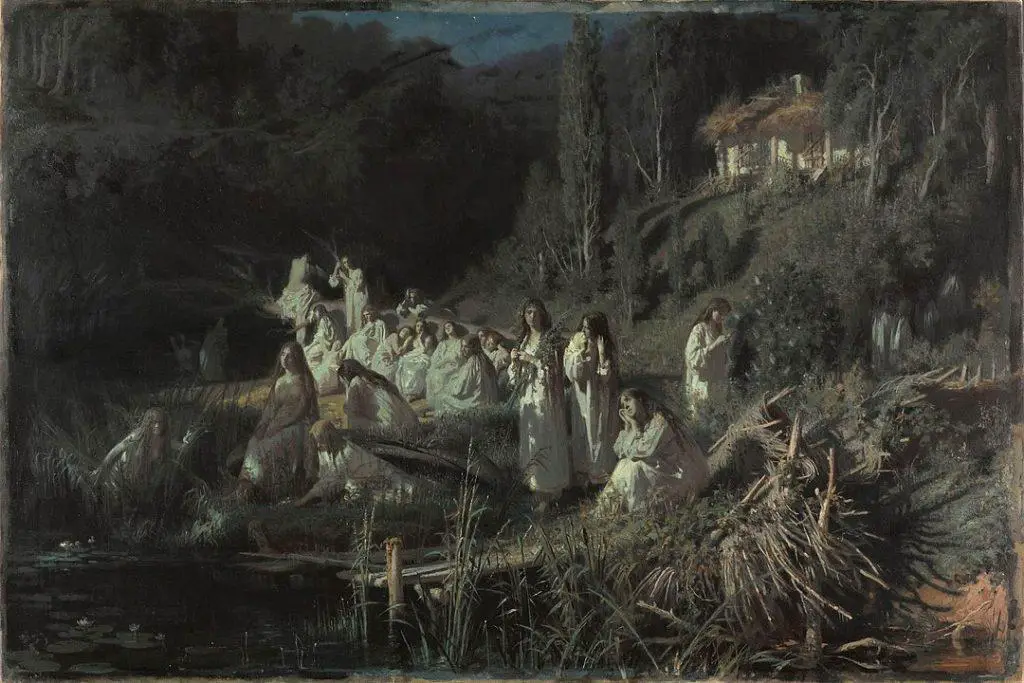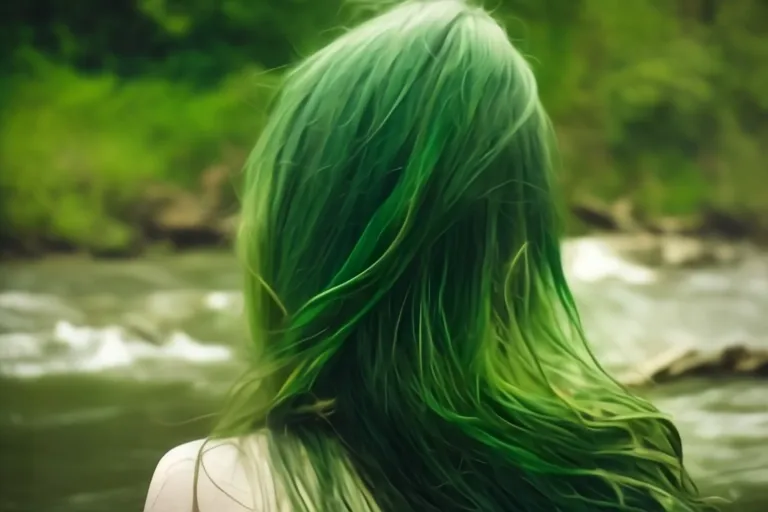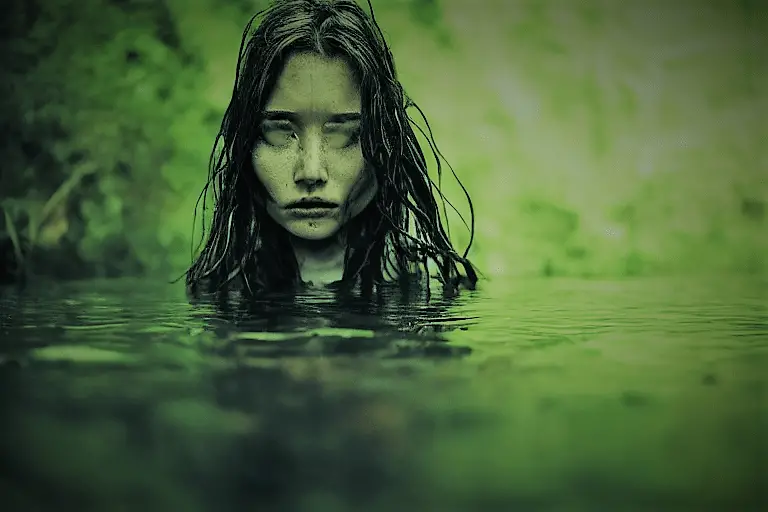Share the Lore!
By: Alex Postrado
Pagan Fertility Wight or Malefic Water Spirits?
Look into their eyes.
It is said that they have no pupils, but if you see the blazing color of green, you better run!
That is how you instantly know a rusalka is purely evil.
Though rusalki are mostly known as water-dwelling creatures, there is no singular way to describe them 一 especially when it comes to their appearance.
In stories from around the Danube River, they are called vile 一 those beautiful mist-robe-wearing charmers, singing sweet hymns to beguile their listeners.
In northern Russia, they are notably hideous. Hunchbacked, invariably naked, and with long, unkempt hair to match. Need I mention they are also wicked to the core?
Across other parts of the Slavic region, the image of the rusalka only further varies.
But the intent remains the same: to entice men 一 often 一 to their cold, bedraggled grave.
From beautiful, naked maidens to awfully pale young girls with inhumanly long arms 一 sometimes even to hairy water monsters 一 there is no doubt why even to this day, the myth of the rusalka remains a folkloric deep dive that scholars, littérateurs, artists, and composers alike still want to immerse in.
Curious about it yet? Here is the tale of the sirens of Slavic lore.

What is the Rusalka?
It is said that the rusalka is often three things: malicious, associated with water, and is commonly female.
Think along the lines of Germanic folklore’s nixie and French mythology’s Melusine 一 only this time, it is Slavic culture that greatly inspires it.
And rusalki 一 depending on the region 一 could either be the soul of an unbaptized child or of a virgin who drowned for whatever reason 一 be it an accident or not.
If the rusalka is the spirit of a dead child, it is said that they would wander around forests, begging each person they come across to baptize them, so that they could ascend and finally have peace.
Beware, though! They are not as innocent as they present themselves to be and if you’re not careful, you could be in for a pretty painful surprise attack.

On the other hand, young girl rusalki are generally believed to help crops flourish.
The lore has it that they could “confer their unused fertility on fields” and that is what ultimately boosts the growth.
Yet they could also be vindictive 一 especially if they died in a violent way or at the hands of someone else.
Nevertheless, in most stories, the rusalka is depicted in a more mature light than these first two.
Toying with the idea of seduction that usually leads to something grim, these tales portray them both as a succubus and a siren of some sort 一 with men getting the short end of the stick, being their ideal prey.
And their unique method of finishing off their victims?
By luring them into the water with their songs 一 as well as their appeal 一 only to submerge them under the surface using their long and loose hair, while their body simultaneously becomes too slippery for the victim to cling on.
It is said that the rusalka would laugh hysterically as their victim drowns. Other times, they would also tickle them to death.
More often than not, in stories like this, the element of betrayal plays out 一 either by the rusalka’s lover, back when she was still human, or by someone she dearly trusted.
It is said that if a woman was double-crossed and killed near any waterway or had her faith broken and ended her life near a body of water, then she would be allowed to avenge her death 一 this time, as a rusalka.
And until vengeance is exacted 一 or in some cases, at least until the “allotted time on earth” is reaped 一 the restless soul of the betrayed would linger on in the form of the rusalka.

Are There Male Rusalka?
If we are to refer to a few tales featuring both the rusalka and its evil male counterpart 一 it would give us the menacing vodyanoy.
Also rooted in Slavic folklore 一 the vodyanoy is commonly depicted as having a more toad-like, rather than humanlike appearance complete with gills, webbed fingers, anuran features, and a skin with a greenish tinge.
Also sometimes described as old men 一 the exterior of the vodyanoy varies from its humanoid form to that of a naked old man, to a bloated and hairy body 一 sometimes covered in slime or at other times, even scales 一 based on differing accounts.
They can be found riding a log and following a river’s current, or passing the time by playing cards, smoking pipes, and watching the streams trickle by.
But don’t let this relaxed visage fool you!
The vodyanoy 一 despite being old 一 is still well-noted in some stories for their malevolence.
As the stories go, the creature is responsible for cases of drownings 一 especially of swimmers who they deem too reckless or bold.
While some accounts don’t explicitly tell of the vodyanoy as an entirely malevolent creature 一 as they sometimes even herd fish into the net of any fisherfolk they favor 一 it is still best to regard them as one who can and will strike if angered.
So, when going for a swim, try not to be too reckless, as lurking in the depths of the water could be the vodyanoy.
The Rusalki Week
The name rusalka comes from the word rusalija, from Byzantine Greek rousália and Roman Rosalia 一 the festival of roses, associated with Pentecost and the days close by it.
It is said that around that time of the year, particularly in early June, rusalki are “at their most dangerous“.
In folklore, they call it the rusalki week 一 also called Green week or Trinity week.
A time when rusalki are believed to rise from the watery depths, climb up trees, sit on the branches with only their feet touching the water below, and comb their hair with fish bones as they wait for their prey.
During the rusalki week, they would also dance madly in circles 一 inviting anyone who sees them, to join.
Yet those who did were forced to dance until they die.
With the dangers attributed to the rusalki week, people in the olden days were advised not to stride by 一 lest swim in 一 open waters in fear of their safety.
At the end of this critical week, though, it is said that grass grows thicker and crops thrive better where the rusalki walked.
Shortly after, ritual banishments or ceremonial burials would be held near waterways 一 expelling the rusalki back into the depths until the next summer.

Pagan Origins of the Rusalka
The supposed happenings during the rusalki week 一 the climbing on trees and perching on branches 一 suggest that rusalki, unlike mermaids, actually have legs.
And if we are to read older versions of the rusalki lore, this particular element appears multiple times.
While it is true that even back then, the rusalka is regarded as a water spirit, the link to mermaids likely only surfaced in the years that followed 一 when the sexuality of female entities in folklore from around the world began being highlighted.
And frankly speaking, that wasn’t the only thing about the rusalka that changed as time went by.
Several folklorists suggest that, initially, rusalki were benevolent water spirits, stemming from ancient Slavic pagan traditions.
Possibly dating back to the 8th century, the original rusalka 一 according to Vladimir Propp 一 was, in fact, pagan deities that rise out of the water during springtime “to transfer life-giving moisture to the fields” 一 ultimately helping with the growth and lushness of the crops.
However, during the 19th century, largely as part of Christian propaganda, the rusalka became associated with evil and death 一 tagged as the being who is no longer alive yet, for some reason, still lingers.
Nowadays, we know of the rusalka as a creature of the cold waters, looking for victims to beguile.
Due to the often contradicting versions of their story, we may sometimes encounter her as vodyanitsa 一 meaning, “she from the water”; loskotukha or “she who tickles“; shutovka or “joker“; kupalka or “bather“; or mavka and several more.
And perhaps, all these names would only bring us back to what was said at the start of this story.
That there is no singular way to describe the rusalka.
Undeniably a multifaceted creature of lore that only further expands in meaning as time goes.
References:
Rusalka - Slavic spirit Rusalka: The Mythical Slavic Mermaid A Guide to the Slavic Folklore of Rusalka Rusalka - Myths and Folklore Rusalka - Gods & Goddess The Rusalka - sirens of the sea THE RUSALKA - Astonishing Legends Supernatural beings in Slavic religion
